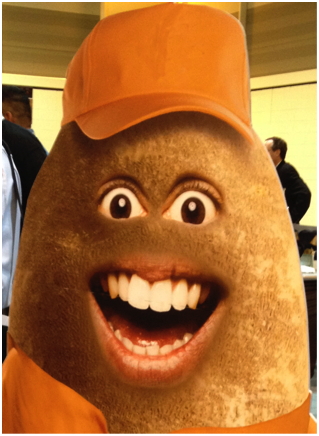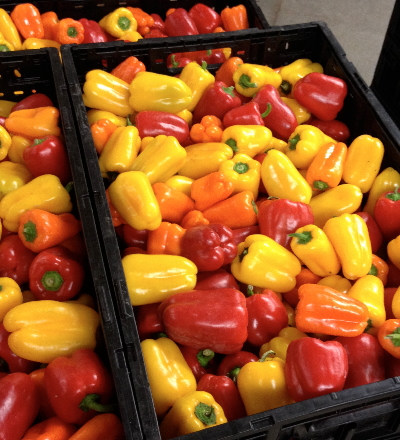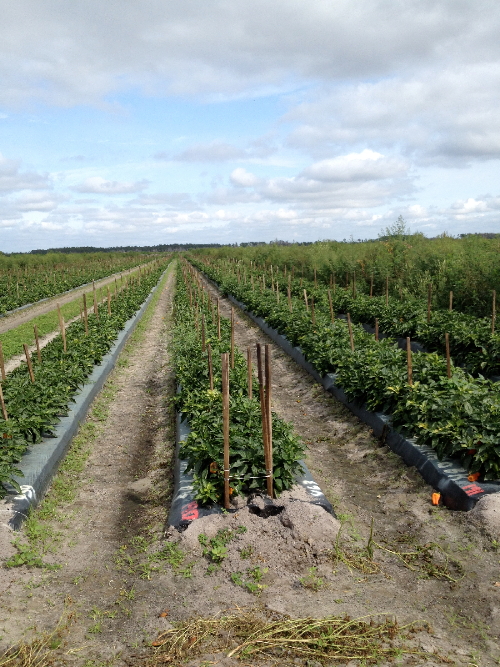(Today, the Flamingo admits his ignorance. Savor the moment – it doesn’t happen often. 🙂 )
Now, I’m a little embarrassed to admit that. After all, I’ve been involved with a couple of farmers’ markets, done some gardening of my own, and considered myself a card-carrying “foodie” for years. But real farming? I didn’t know “squash.”
All it took to point up my ignorance was a tour of one of Bailey Farms’ fields out Bonita Springs, Florida way. The focus of the trip was their Bella Fina peppers, a tri-colored pepper variety developed by Monsanto subsidiary Seminis.* Bred to be sweet, crunchy, and attractive to kids (although I’m not sure I would waste such a fine pepper on any children in my household. If I had any.), they were very attractive to me.
But this post is about me, so back to the issue of my farm-ignorance.
Okay, it’s Sherlock Holmes time. What’s right about this picture? At least about my presumptions as I was looking over the view. You got it, practically nothing. First, how about the big, tall weeds over on the right? What’s the right answer?
- A fallow row that’s “recharging”
- To separate one field from the next.
- They just forgot about that one.
Actually, none of the above. (Yeah, it’s a trick question.) My guess was actually (A) but the real answer is that it’s a windbreak. The Baileys have farms in North Carolina as well as Florida, and this is not something that they do up there. As the old Florida tourism campaign used to say “This is Florida, the rules are different here.” That applies to farming like everything else. As Mike Clevenger, the farm’s manager, says, growing crops in southwest Florida is like planting on a beach. It’s all sand. And when the wind kicks up, those sand particles with their jagged little edges go flying through the field like micro-razor blades, slicing up leaves as they go. So the weeds are a fast-growing windbreak to protect the peppers.
So far I’m 0 for 1. Now, when is an acre not an acre? Take your time; you’re looking right at it (just like I was). Of course! There’s all that empty space between the plants. So for every acre you plant, you’re really only getting half-an acre that bears. If you’re lucky. Few farmers are that lucky, particularly in Florida. Unlike our readers in the Western states (who barely remember what rain is), growers in Florida deal regularly with thunderstorms that can drop 2-3 inches of rain in the space of a half-hour. Again, the sandy soil of South Florida is all bad news; tons of water will remain long enough to possibly drown plants, but will be long gone before they provide any nourishment. This means the water has to be pumped out of the field as quickly as possible, and it has to go someplace. That someplace is a miniature Venice of canals and catch-basins that allows the remnants of the deluge to sink back into the water table. Unfortunately, that takes up a lot of space, and the amount of land given over to actual food production dwindles further. Just because a farmer technically has, let’s say, 500 acres, doesn’t mean he gets crops out of anywhere near that amount of land.
Zero for two; I’m beginning to think of myself as an “urban bumpkin.” Finally, just to add insult to injury, I concluded that the rows of Mexican sunflowers planted near the peppers had the obvious purpose: to attract bees. These peppers have to be pollinated, right? Nope. Wrong, again. These peppers are self-pollinating. They do, however, need protection. In this case, the Mexican sunflowers are nurseries for pirate bugs that prey on the Western thrip— a tiny insect that considers a developing pepper the equivalent of the all-you-can-eat buffet. Luckily, the pirate bugs look on the thrip the same way, so far less pesticide goes onto the field to control the thrips. Which puts me at zero for three— making my agricultural IQ somewhere in the negative range.
But I’m a Flamingo. Pass the shrimp.
*Yes, that Monsanto. We’re not getting into any of the controversies surrounding that association, here. At least, not right now. We can assure you that the Bella Fina pepper varieties (and all of Bailey Farms’ produce) were developed through good old-fashioned cross-pollination techniques, and are absolutely not “GMO/transgenic”. Remember Gregor Mendel and the pea plants from elementary school science class? Yeah. Like that. — RJ
We received a stipend to offset our travel costs in connection with our field trip to Bailey Farms in Bonita Springs, Florida, as well as some crispy and delicious Bella Fina mini bell peppers from Bailey Farms. Some of which we had to pick ourselves. All opinions are our own, as always. Really? You had doubts? Please.




What a great opportunity! Thanks for sharing your learnings – pretty sure I’d have been 0 for 3 as well!